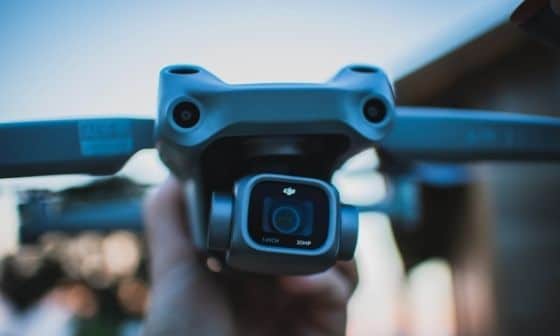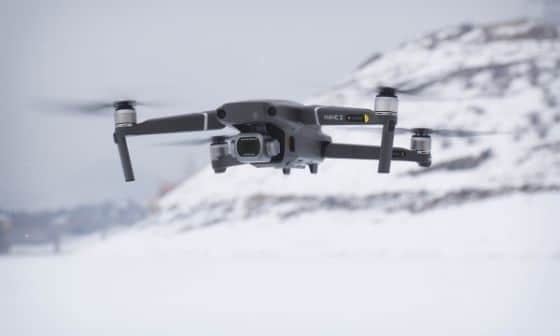The Mavic 2 Pro is a top-of-the-line prosumer drone that is highly versatile for various professional purposes, such as photogrammetry, photography, and videography. One of its main highlights is its Hasselblad-engineered camera, which features a 20MP 1-inch sensor, adjustable aperture, and Hasselblad's Natural Colour solution technology, ensuring highly accurate colour representation in every image. The camera can record video footage in 4k at 30fps with a maximum bitrate of 100Mbps and provides the option to record in 10-bit Dlog and HLG for HDR videos. Additionally, the drone features obstacle avoidance technology, multiple autonomous flight modes, OcuSync 2.0 for long-range image transmission, and a flight time of up to 30 minutes.
Key Features
- 1-inch CMOS sensor with 28mm lens & 77° FOV
- F/2.8-f/11 adjustable aperture
- 20MP images
- HNCS natural colour technology
- Single shot, burst, AEB, interval & panorama photography modes
- Records video footage in 4k at 30fps, 2.7k at 60fps, 1080p at 120fps
- Records in 10-bit Dlog-M & HLG for HDR videos
- Intelligent flight modes
- 30 minutes of flight time
- 8km transmission range
The DJI Mavic 2 Pro, released in 2018, was a groundbreaking drone with a compact design and advanced features. Despite DJI discontinuing production, it remains a top choice for drone photography. However, DJI has since released newer models that offer similar or superior features to the Mavic 2 Pro.
The Mavic Air 2S, for example, is a lightweight and affordable drone with a 1-inch image sensor. The recently released Mavic 3 offers even more advanced features, including a dual-camera system and foldable design, though it comes with a higher price tag.
The Mavic 2 Pro is a versatile and feature-rich drone that excels in commercial applications, particularly in photography and videography.
If purchasing for commercial purposes, it is important to register the drone with the appropriate aviation regulatory agency, such as obtaining a Part 107 certificate from the FAA in the US or a Flyer ID and Operator ID from the CAA in the UK.
DJI Mavic 2 Pro Review
The Mavic 2 Pro retains the compact and foldable design that made its predecessor so popular. Despite being slightly heavier, it still weighs less than 1kg and measures 214×91×84 mm when folded, making it easy to pack and travel with.
Built with high-quality ABS polymer and a magnesium alloy internal frame, the Mavic 2 Pro is sturdy and can operate in extremely cold temperatures up to -10°C with a wind resistance of 23 mph. However, it is not waterproof like most prosumer drones.
Powered by a smart LiPO battery, the Mavic 2 Pro provides around 30 minutes of flight time with LED lights indicating the power level. The battery has intelligent features to prevent overcharging, discharge when not in use, and protect against short-circuiting. Consider purchasing an additional battery to extend flight time.
One major upgrade from the original Mavic drone is the omnidirectional obstacle avoidance system. With sensors on the front, back, both sides, top, and bottom, the Mavic 2 Pro has cameras and infrared sensors to avoid obstacles. The sensors on the bottom also help the drone maintain altitude and fly indoors. An LED light on the bottom assists with low-light navigation and landing.
The Mavic 2 Pro has 8GB of internal storage and a memory card slot that can take a maximum of 128 GB. It is recommended to purchase a memory card, especially when capturing 4k video footage.
The upgraded remote controller has an LCD screen to display drone telemetry data and uses DJI’s OcuSync 2.0 enhanced transmission technology, allowing a transmission range of up to 8km. The technology also reduces latency for live HD video streaming to your smartphone. The controller includes clamps to attach a large smartphone.
To make full use of all features, download the DJI GO 4 App, which gives access to autonomous flight modes, advanced camera settings, flight settings, and a simple video editor. The app displays flight data and a small map and provides warnings in no-fly zones. It is available for both Android and iOS devices.
DJI Mavic 2 Pro Camera

Undoubtedly, the most notable feature of the Mavic 2 Pro is its camera, which is one of the best on any prosumer drone and one of the few foldable drones with a 1-inch image sensor.
The camera was engineered by DJI in collaboration with legendary Swiss camera maker Hasselblad. It boasts a 20MP 1-inch CMOS sensor, a 28mm lens, a variable aperture of f/2.8 – f/11, and a 77° field of view.
The adjustable aperture provides greater control over exposure levels, allowing for shooting in aperture or shutter priority, as well as manual mode. The camera incorporates Hasselblad’s Natural Color Solution technology, which enables photographers to capture images with remarkable colour accuracy in both RAW and JPEG file formats.
There are five photography shooting modes: single shot, burst shooting, AEB, panorama, and interval. When it comes to recording videos, the camera can capture 4k video footage at 30fps and has a maximum recording rate of 100Mbps. It can also record 2.7k videos at 30fps and slow-motion videos in FHD at 120fps. Videos can be recorded in MOV & MP4 formats and support H.264 & H.265 codecs.
For HDR videos, there is an option to record in 10-bit Dlog-M or HLG colour profiles, allowing users to record flatter colour profiles that can be enhanced in post-processing.
In conclusion, this is an outstanding camera that can capture stunning aerial images and videos for both amateurs and professionals. Although it was probably the best drone for photography at the time of its release, there are now several alternatives, some of which are more affordable, such as the DJI Mavic Air 2 and Air 2S.
Flight Features & Performance

The Mavic 2 Pro, like most DJI consumer drones, features 3 flight modes: positional, sports, and tripod mode.
Positional mode is the default mode that works best in areas with a strong GPS signal, obstacle avoidance, and autonomous flight modes enabled. It has a maximum speed of 31 mph.
Tripod mode, also known as cinematic mode, is similar to positional mode except for the reduced maximum speed of just 2.2 mph.
Sports mode features more sensitive controls, with disabled vision systems and unavailable autonomous flight modes. This mode can reach a speed of 44 mph.
Intelligent flight modes, such as active track, point of interest, waypoint, and tap fly, are included with the drone. Hyperlapse mode allows users to create 4k time-lapse videos with autonomous flight modes that can only be accessed via the hyperlapse tab on the DJI GO 4 app.
QuickShots is another feature that allows users to easily record short, high-quality video footage from 6 different angles autonomously. These short videos are fun to take with family and friends and can be easily edited and shared on social media via the GO 4 App.
The Mavic 2 Pro also features an automatic return to home feature, a safety feature that minimizes the risk of losing your drone in mid-flight by automatically returning it to its home point whenever the drone battery gets low on charge, or you lose connection for more than 2 seconds. This feature can also be activated manually via the remote controller or the GO 4 App.
Flying the Mavic 2 Pro is effortless, even for beginners, with its dual GPS module, advanced flight controller, one-button take-off/landing, and automatic return-to-home feature.
The obstacle avoidance system is one of the best in the DJI range, although it may struggle in areas with many obstacles in close proximity.
The Mavic 2 Pro’s camera is one of the best camera drones on the market, engineered by Hasselblad and equipped with innovative natural colour technology. Videos are streamed in HD at 30fps with DJI’s OcuSync 2.0 long-range image transmission technology.
The drone can handle windy conditions and has a flight time of around 27 minutes in decent weather conditions.
What Is The Difference Between The Mavic 2 Pro & Zoom?
The Pro and Zoom are two versions of the same drone that DJI released in 2018. Although they share many features, there are a few key differences between the two models:
- Camera: The Mavic 2 Pro is equipped with a Hasselblad camera that uses a 1-inch CMOS sensor, which is capable of capturing 20-megapixel images and records 4K videos at 60fps. The Mavic 2 Zoom, on the other hand, has a smaller 1/2.3-inch sensor and a zoom lens that can go from 24mm to 48mm.
- Image Quality: Because of the larger sensor size, the Mavic 2 Pro generally produces higher-quality images than the Mavic 2 Zoom, especially in low-light conditions. However, the Mavic 2 Zoom has a few unique features, like the Dolly Zoom effect, which can create a visually stunning shot.
- Price: The Mavic 2 Pro is generally more expensive than the Mavic 2 Zoom due to its advanced camera system and higher-quality imaging capabilities.
The Mavic 2 Pro is better suited for photographers and videographers who want the highest quality images and videos. While the Mavic 2 Zoom is more suited for those who want to zoom in on subjects and create unique visual effects.
Final Thoughts
The Mavic 2 Pro is a fantastic camera drone that is suitable for professional photographers. Its compact and foldable design makes it easy to carry around a great choice for a travel-friendly drone.
However, it has been a few years since its release and there are a few alternatives that you may want to consider. The DJI Air 2S compares well against the Mavic 2 Pro, it comes with similar features but is much cheaper. Other drones include the Air 2S and the more expensive Mavic 3.


